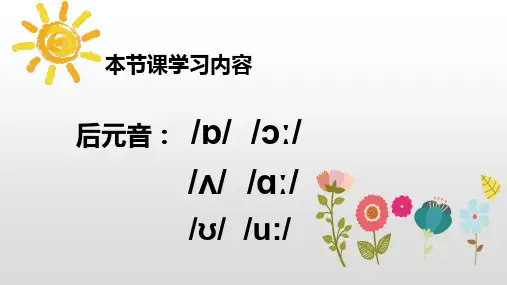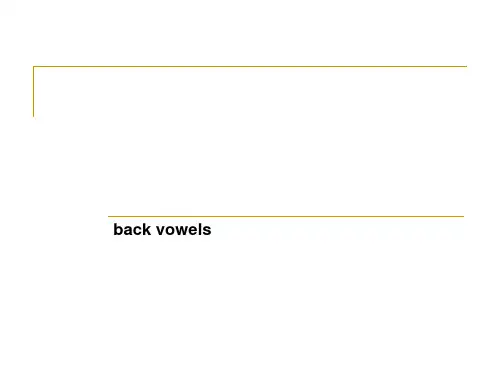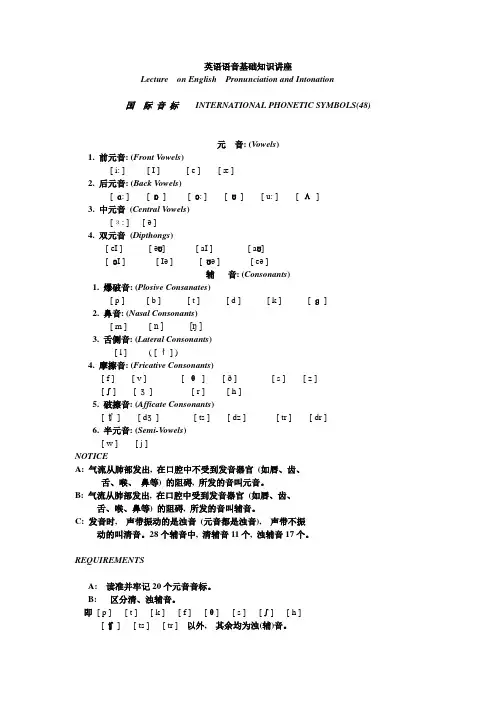后元音back vowels精品PPT课件
- 格式:ppt
- 大小:401.50 KB
- 文档页数:25











英语语音基础知识讲座Lecture on English Pronunciation and Intonation国际音标INTERNATIONAL PHONETIC SYMBOLS(48)元音: (V owels)1. 前元音: (Front V owels)[ i:] [ I ][ e] [æ ]2. 后元音: (Back V owels)[ ɑ:][ ɒ] [ ɔ: ] [ ʊ][ u:] [ Λ]3. 中元音(Central V owels)[з: ] [ ə ]4. 双元音(Dipthongs)[eI ] [ əʊ] [ aI ] [ aʊ][ ɔI ] [ Iə ] [ ʊə ] [ eə ]辅音: (Consonants)1. 爆破音: (Plosive Consanates)[ p ] [ b ] [ t] [ d] [ k ] [ ɡ]2. 鼻音: (Nasal Consonants)[m ] [n ] [ŋ ]3. 舌侧音: (Lateral Consonants)[ l ] ( [ ł] )4. 摩擦音: (Fricative Consonants)[ f ] [ v ] [ θ] [ ð ] [ s ] [ z][∫][ ʒ] [ r] [ h ]5. 破擦音: (Afficate Consonants)[ ʧ] [ dʒ] [ ts ] [ dz ] [ tr ] [ dr ]6. 半元音: (Semi-V owels)[ w ] [ j]NOTICEA: 气流从肺部发出, 在口腔中不受到发音器官(如唇、齿、舌、喉、鼻等) 的阻碍, 所发的音叫元音。
B: 气流从肺部发出, 在口腔中受到发音器官(如唇、齿、舌、喉、鼻等) 的阻碍, 所发的音叫辅音。
C: 发音时, 声带振动的是浊音(元音都是浊音), 声带不振动的叫清音。
28个辅音中, 清辅音11个, 浊辅音17个。
Unit 6Lesson Plan(With Notes for Teachers)Back VowelsDate: Oct. 21-25Class: Classes 1, 2 & 3, Grade 2002Subject: English Pronunciation for CommunicationPurpose:The students will learn back vowels in English.Objectives: Students will be able to:1.Define - in their own words a definition for back vowels;pare –based on the understanding of the basic concept, compare them with othervowels;3.Practice – imitate the sounds and do practice.Resources/Materials:1.Textbook: Wang, Guizhen, An English Pronunciation Course, Higher Education Press,Beijing, 2000;2.Handouts: illustration of the phonemes in focus;3.Recordings of native speakersActivities and Procedures:1.Stimulating: Begin by asking the class to find out how much the students know about whatthey are required to learn. Make sure that it serves the purpose of stimulating the students to think about the issue and have the desire to find out the answers themselves.2.Display examples by playing the recording of the native speakers showing the typicalpronunciation in English.3.Ask the students to listen to the tapes to make a good discrimination of the sounds in focus.4.Have the students imitate the sound in focus.5.Have the students share what they have learned by reading out the practice materials in pairs.6.Have the students listen to the conversations recorded by native speakers of English and tryto get the sounds in focus correct in their pronunciation.7.Have the students practice the guided conversation. Ask them to pay special attention to thesounds in focus in speech.8.Highlight the language function in the conversation in the practice.9.Have several pairs of the students present their conversation in the class.ment on the students’ performance by highlighting the achievement of the students andthe efforts they need for the improvement.11.Ask the students to do more practice after class and get ready for presentation during the nextsession.Notes for TeachersBack VowelsIn this unit, we will learn the back vowels in English.There are six back vowels in English. The back vowels are produced by shifting the body of the tongue back from its central position. The tip of the tongue remains at the level of the lower teeth. The front and back vowels have several features in common as well as some differences. Unlike the front vowels that are made with a fairly neutral lip posture, four of the back vowels are rounded. The back vowels may also be subdivided into those that are high (/u:/ and /☺/), mid (/ :/ and /ɒ/), and low (/ :/ and /✈/). The following is the description of the six English back vowels./u:/ and /☺//u:/ and /☺/ are both high, back, rounded vowels. The /u:/ marks the highest boundary for the back vowels, as /i:/ does for the front vowels. Therefore, the tongue is retracted from its rest position and raised toward the soft palate. This vowel is quite common in the languages of the world and appears without problem in most Chinese learners. Along with /u:/, /☺/ completes the vowels in the high back space on the vowels chart. Its corresponding front vowel is /✋/. When making the sound, the tongue is retracted as for /u:/ but not elevated to the same extent. In addition, the /☺/ vowel is not made with as much tension in the root of the tongue as /u:/. The same tense/lax contrast is also seen for /i:/ and /✋/. This sound is not found very frequently as a phoneme in the languages of the world, certainly not in Chinese Putonghua. In English, it is not very common despite the fact that it appears in some frequently used words, such as should, good, and book. /u:/ occurs at all the three positions of a word while /☺/ occurs only in the middle position of a word, like book and hook. To ensure correct pronunciation, it is important to make the following distinction between /u:/ and /☺/:1./u:/ is the highest back vowel, so the raised part of the tongue for /u:/ is higher than that for /☺/;2.the part of the tongue raised for /☺/ is not as back as that for /u:/;3./u:/ has quite strong lip rounding while the lips are only slightly rounded for /☺/./ :/ & /ɒ// :/ is a mid-back vowel. For its production, the tongue is retracted and almost flat in the mouth. The vowel is almost fully back and has quite strong lip-rounding. /ɒ/ is a low vowel. The lips are slightly rounded. /ɒ/ is a difficult vowel for the Chinese learners. Many of them use a shortened version of / :/ as its substitution. To ensure correct pronunciation, it is important to make the following distinction between these two vowels:1./ɒ/ is a low vowel while / :/ is a mid vowel, so the mouth is more open for /ɒ/,2./ :/ has quite strong lip rounding while the lips are only slightly rounded for /ɒ/./ :/ & /✈/The / :/ is made by lowering and flattening the tongue in the oral cavity. It is a low vowel, but not as back as other back vowels in English. /✈/ is quite different from other vowels in thisgroup in that it is more like a central vowel than a back vowel (see the vowel chart). /✈/ is made with the tongue in the approximate middle of the mouth, perhaps shifted back slightly. It is lower than the other central vowels /з:/ and /✈/. The lip position is neutral. It is important for the learners to make a clear distinction between / :/ and /✈/ in their pronunciation.元音: 后元音在这个单元里,我们将学习英语的后元音。